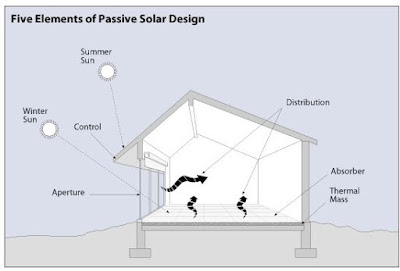Passive solar design refers to the use of the sun’s energy for the
heating and cooling of living spaces by exposure to the sun. When sunlight
strikes a building, the building materials can reflect, transmit, or absorb the
solar radiation. In addition, the heat produced by the sun causes air movement
that can be predictable in designed spaces. These basic responses to solar heat
lead to design elements, material choices and placements that can provide
heating and cooling effects in a home.
 Unlike active solar heating systems, passive systems are simple and do
not involve substantial use of mechanical and electrical devices, such as
pumps, fans, or electrical controls to move the solar energy.
Unlike active solar heating systems, passive systems are simple and do
not involve substantial use of mechanical and electrical devices, such as
pumps, fans, or electrical controls to move the solar energy.
Passive Solar Design Basics
A
complete passive solar design has five elements
·
Aperture/Collector: The large glass area through which sunlight enters the
building.
The aperture(s) should face within 30 degrees of true south and should
not be
shaded by other buildings or trees from 9a.m. to 3p.m. daily during the
heating
season.
·
Absorber: The hard, darkened surface of the storage element. The surface,
which
could be a masonry wall, floor, or water container, sits in the direct path of
sunlight. Sunlight hitting the surface is absorbed as heat
.
·
Thermal mass: Materials that retain or store the heat produced by sunlight.
While the absorber is an exposed surface, the thermal mass is the material
below
and behind this surface
.
·
Distribution: Method by which solar heat circulates from the collection and
storage points to different areas of the house. A strictly passive design will
use
exclusively. In some applications, fans, ducts and blowers may be
used to
distribute the heat through the house.
·
Control: Roof overhangs can be used to shade the aperture area during
summer months. Other elements that control under and/or overheating include
electronic sensing devices, such as a differential thermostat that signals a
fan to
turn on; operable vents and dampers that allow or restrict heat flow;
low-
emissivity blinds; and awnings.
Passive Solar Heating
The
goal of passive solar heating systems is to capture the sun’s heat within the
building’s elements and to release that heat during periods when the sun is
absent, while also maintaining a comfortable room temperature. The two primary
elements of passive solar heating are south facing glass and thermal mass to
absorb, store, and distribute heat.
Passive Solar Cooling
Passive solar cooling systems work
by reducing unwanted heat gain during the day, producing non-mechanical
ventilation, exchanging warm interior air for cooler exterior air when
possible, and storing the coolness of the night to moderate warm daytime
temperatures. At their simplest, passive solar cooling systems include
overhangs or shades on south facing windows, shade trees, thermal mass and
cross ventilation.





No comments:
Post a Comment